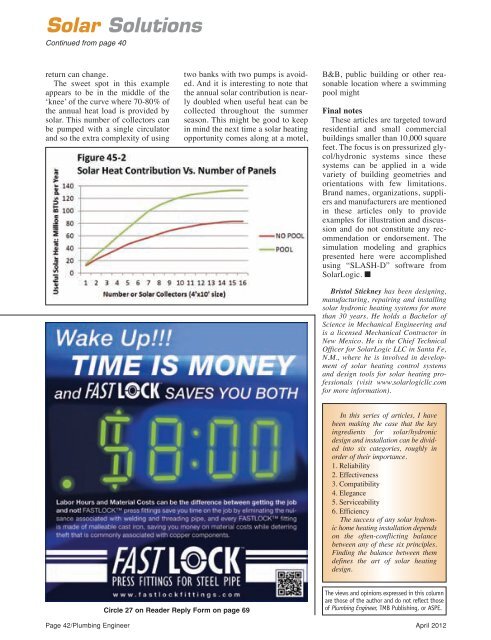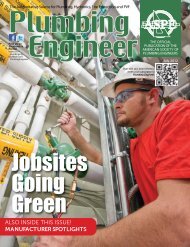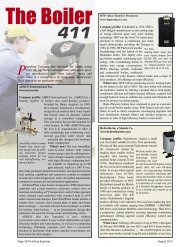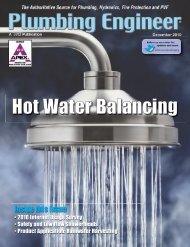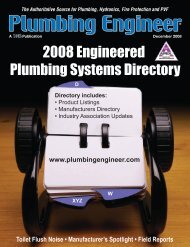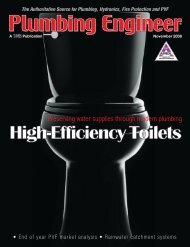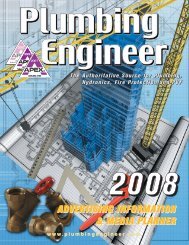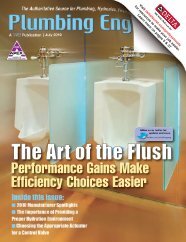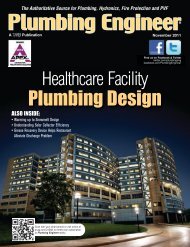open issue - Plumbing Engineer
open issue - Plumbing Engineer
open issue - Plumbing Engineer
You also want an ePaper? Increase the reach of your titles
YUMPU automatically turns print PDFs into web optimized ePapers that Google loves.
Solar Solutions<br />
Continued from page 40<br />
return can change.<br />
The sweet spot in this example<br />
appears to be in the middle of the<br />
‘knee’ of the curve where 70-80% of<br />
the annual heat load is provided by<br />
solar. This number of collectors can<br />
be pumped with a single circulator<br />
and so the extra complexity of using<br />
two banks with two pumps is avoided.<br />
And it is interesting to note that<br />
the annual solar contribution is nearly<br />
doubled when useful heat can be<br />
collected throughout the summer<br />
season. This might be good to keep<br />
in mind the next time a solar heating<br />
opportunity comes along at a motel,<br />
B&B, public building or other reasonable<br />
location where a swimming<br />
pool might<br />
Final notes<br />
These articles are targeted toward<br />
residential and small commercial<br />
buildings smaller than 10,000 square<br />
feet. The focus is on pressurized glycol/hydronic<br />
systems since these<br />
systems can be applied in a wide<br />
variety of building geometries and<br />
orientations with few limitations.<br />
Brand names, organizations, suppliers<br />
and manufacturers are mentioned<br />
in these articles only to provide<br />
examples for illustration and discussion<br />
and do not constitute any recommendation<br />
or endorsement. The<br />
simulation modeling and graphics<br />
presented here were accomplished<br />
using “SLASH-D” software from<br />
SolarLogic. n<br />
Bristol Stickney has been designing,<br />
manufacturing, repairing and installing<br />
solar hydronic heating systems for more<br />
than 30 years. He holds a Bachelor of<br />
Science in Mechanical <strong>Engineer</strong>ing and<br />
is a licensed Mechanical Contractor in<br />
New Mexico. He is the Chief Technical<br />
Officer for SolarLogic LLC in Santa Fe,<br />
N.M., where he is involved in development<br />
of solar heating control systems<br />
and design tools for solar heating professionals<br />
(visit www.solarlogicllc.com<br />
for more information).<br />
In this series of articles, I have<br />
been making the case that the key<br />
ingredients for solar/hydronic<br />
design and installation can be divided<br />
into six categories, roughly in<br />
order of their importance.<br />
1. Reliability<br />
2. Effectiveness<br />
3. Compatibility<br />
4. Elegance<br />
5. Serviceability<br />
6. Efficiency<br />
The success of any solar hydronic<br />
home heating installation depends<br />
on the often-conflicting balance<br />
between any of these six principles.<br />
Finding the balance between them<br />
defines the art of solar heating<br />
design.<br />
Circle 27 on Reader Reply Form on page 69<br />
The views and opinions expressed in this column<br />
are those of the author and do not reflect those<br />
of <strong>Plumbing</strong> <strong>Engineer</strong>, TMB Publishing, or ASPE.<br />
Page 42/<strong>Plumbing</strong> <strong>Engineer</strong> April 2012


